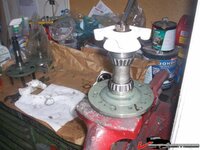MYBAD79
Moderator
Here's a photo of the rear wheel bearings and spacer and shim installed on a slip fitted spindle (setup tool):

Why can't this setup tool simply be a f.e 3/4" bolt ?
Unfortunately I missed the opportunity to take the same picture with the bearings setup on a bolt... unless I'm missing something here i don't see why the tight radial fit is necessary. To measure endplay it should be just as good and just as precise to use a long 3/4" bolt and washers so that the torque is applied to the inner race of the bearing.
not ???

Why can't this setup tool simply be a f.e 3/4" bolt ?
Unfortunately I missed the opportunity to take the same picture with the bearings setup on a bolt... unless I'm missing something here i don't see why the tight radial fit is necessary. To measure endplay it should be just as good and just as precise to use a long 3/4" bolt and washers so that the torque is applied to the inner race of the bearing.
not ???
